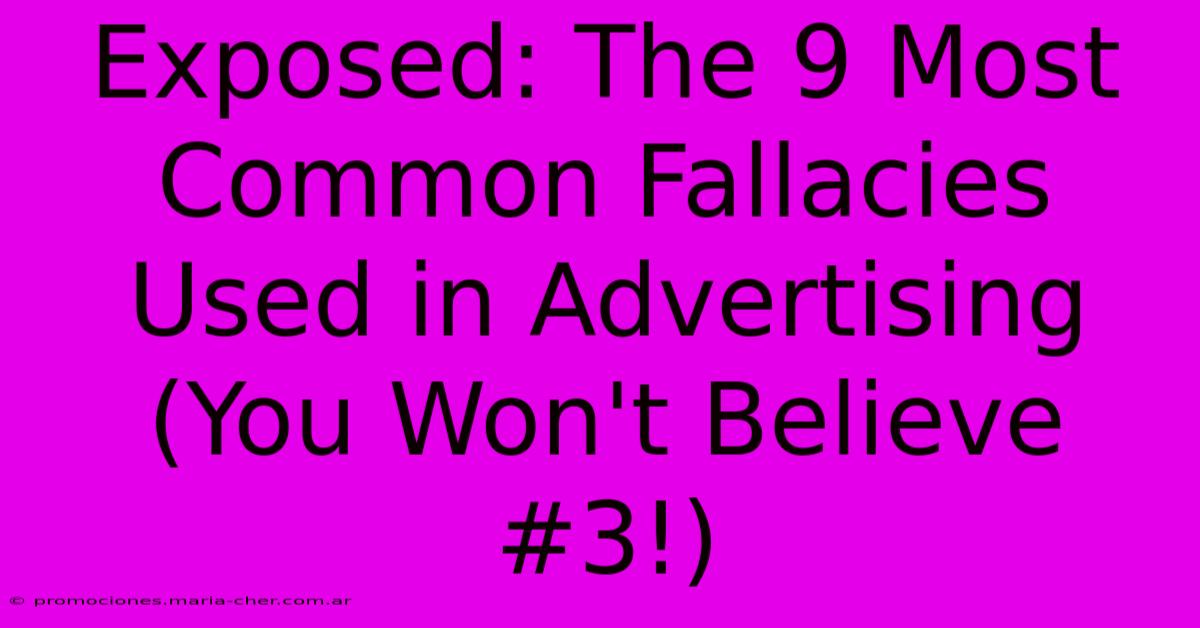Exposed: The 9 Most Common Fallacies Used In Advertising (You Won't Believe #3!)

Table of Contents
Exposed: The 9 Most Common Fallacies Used in Advertising (You Won't Believe #3!)
Advertising is everywhere. It bombards us daily, subtly shaping our desires and influencing our purchasing decisions. But behind the glossy images and catchy slogans often lie logical fallacies – flaws in reasoning that manipulate our emotions rather than appealing to our logic. Understanding these fallacies is crucial to becoming a more discerning consumer and to avoid falling prey to misleading marketing tactics. Let's expose the nine most common ones:
1. Bandwagon Fallacy: "Everyone's Doing It!"
This classic fallacy plays on our innate desire to belong. Advertisements using this technique imply that because many people use a product or service, it must be good. Example: "Millions of people use Brand X – shouldn't you?" The sheer number of users is presented as proof of quality, ignoring the possibility that the popularity might stem from other factors like effective marketing or simple coincidence.
2. Appeal to Authority: "A Celebrity Says So!"
This fallacy leverages the credibility of a well-known figure to endorse a product, regardless of their expertise on the subject. Example: A famous athlete endorsing a brand of running shoes, even though they might not be involved in the design or manufacturing process. We are encouraged to trust the celebrity's judgment without critical evaluation.
3. False Dilemma (Either/Or): "It's This or That!" (You Won't Believe This One!)
This sneaky tactic limits our choices to only two options, one of which is obviously undesirable. Example: "Choose Brand X or settle for inferior quality." This ignores the possibility of other brands or options existing on the market, forcing a decision based on a limited and biased perspective. This is a particularly powerful fallacy because it simplifies complex choices.
4. Hasty Generalization: "One Good Experience = Always Good!"
This fallacy draws broad conclusions from limited evidence. A single positive experience is used to represent the overall quality of a product or service. Example: "I loved my first experience with this restaurant, so it must always be amazing!" This overlooks the possibility of inconsistent service or quality.
5. Red Herring: "Distraction, Distraction!"
This fallacy introduces an irrelevant topic to divert attention away from the main issue. Example: An advertisement focusing on the stylish design of a car instead of addressing its poor fuel economy or safety features. This shifts the focus from critical aspects to superficial elements.
6. Slippery Slope: "One Step Leads to Disaster!"
This fallacy argues that one action will inevitably lead to a series of negative consequences. Example: "If you don't buy this insurance, you'll face financial ruin!" This exaggerates the potential consequences and lacks evidence to support such a drastic outcome.
7. Appeal to Emotion: "Tugging at Your Heartstrings!"
Instead of using logic, this technique relies on emotional appeals such as fear, guilt, or joy to persuade the audience. Example: Advertisements showing sad animals to promote donations to an animal charity. While worthy causes can utilize emotion, this approach bypasses rational consideration.
8. Straw Man: "Misrepresenting the Opposition!"
This involves misrepresenting an opposing argument to make it easier to refute. Example: A car company might portray a competitor's vehicle as unreliable based on a single incident, ignoring the overall positive reviews. This creates a false narrative to discredit the competition.
9. Appeal to Novelty: "It's New, So It's Better!"
This fallacy assumes that simply because something is new, it must be superior. Example: "The latest technology guarantees better performance!" This disregards the possibility that older, established products might still offer superior features or value.
By recognizing these common advertising fallacies, you can become a more informed and critical consumer, making purchasing decisions based on reason rather than manipulation. Don't let clever marketing tactics cloud your judgment!

Thank you for visiting our website wich cover about Exposed: The 9 Most Common Fallacies Used In Advertising (You Won't Believe #3!). We hope the information provided has been useful to you. Feel free to contact us if you have any questions or need further assistance. See you next time and dont miss to bookmark.
Featured Posts
-
Unlock The Secret To Ear Perfection Elevate Your Style With A Second Piercing
Feb 07, 2025
-
The Ultimate Empowerment Tool Everything You Need Right At Your Fingertips
Feb 07, 2025
-
Breadth Of Baguette Colors A Visual Feast For The Hungry Eye
Feb 07, 2025
-
Shocking Truth Revealed Are Your Favorite Brands Deceiving You With Ad Fallacies
Feb 07, 2025
-
From A To Z A Rainbow Of Colourful And Colourful Words
Feb 07, 2025
